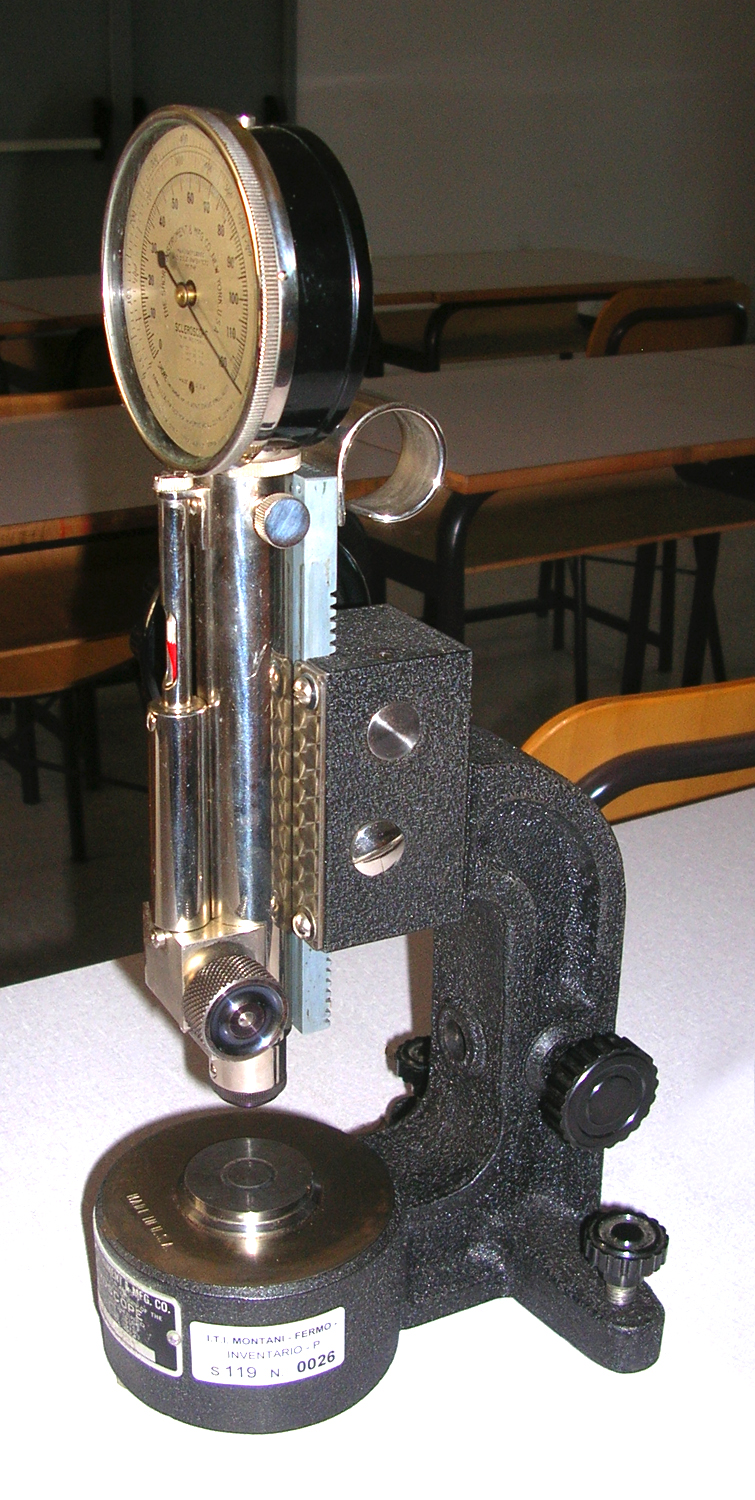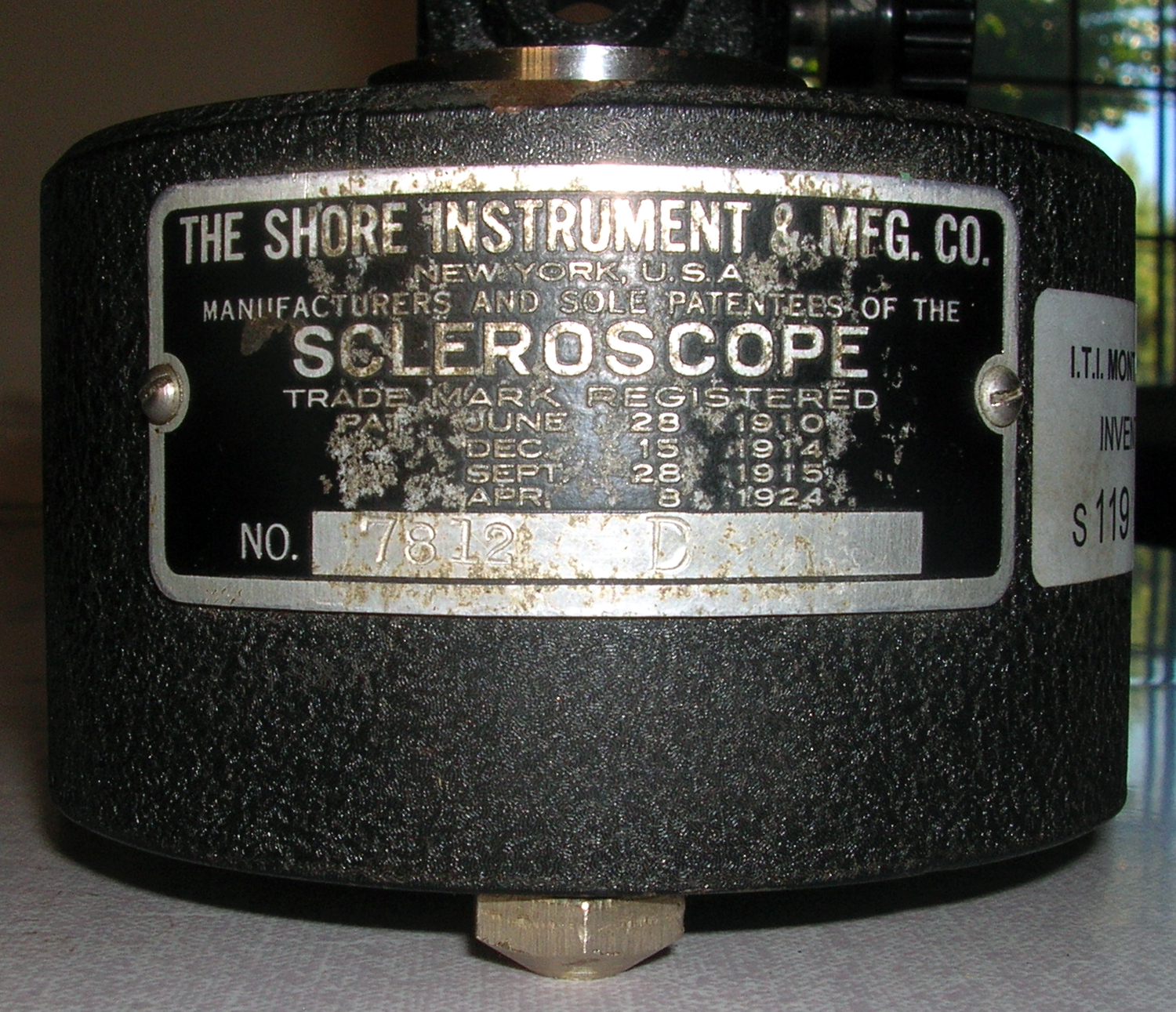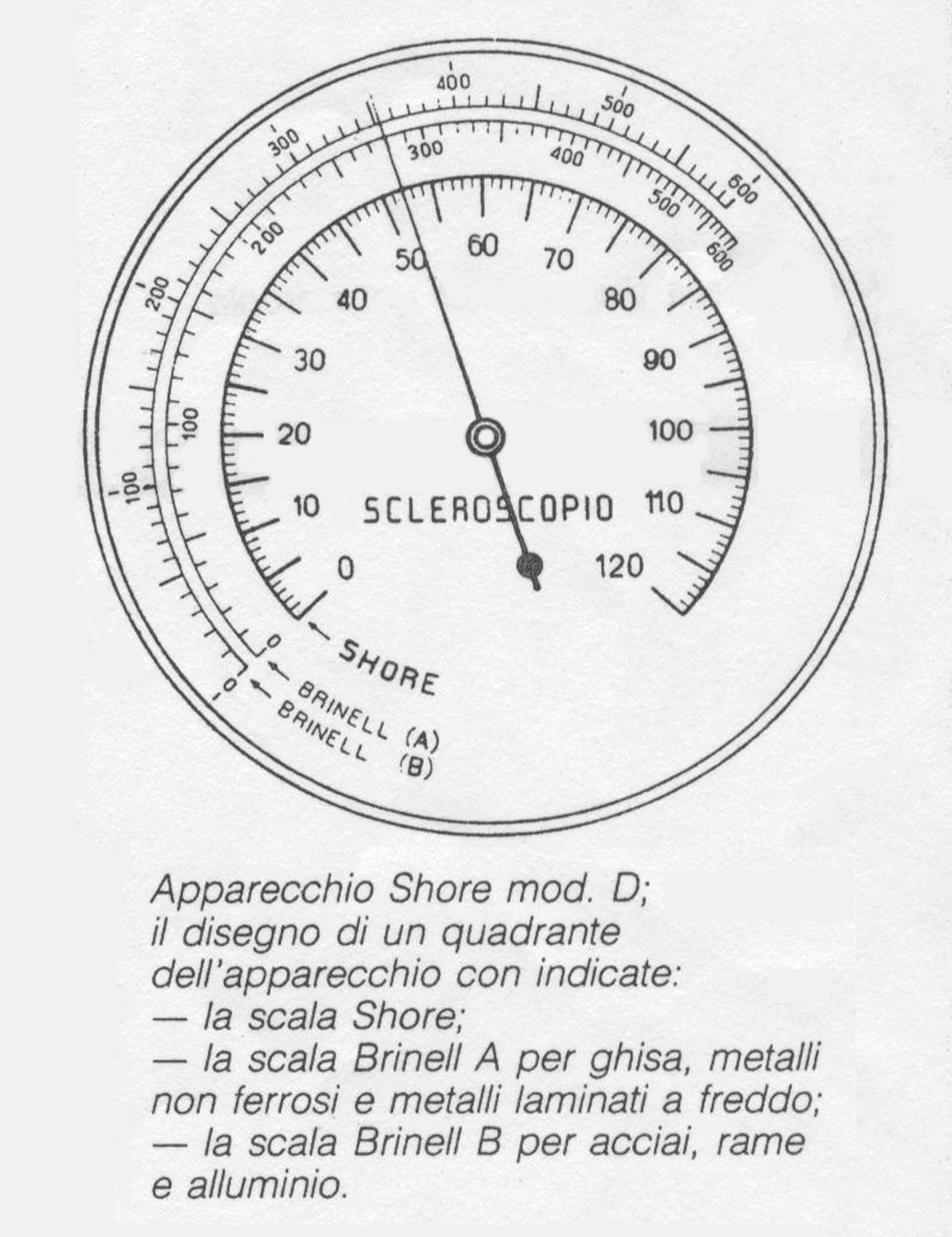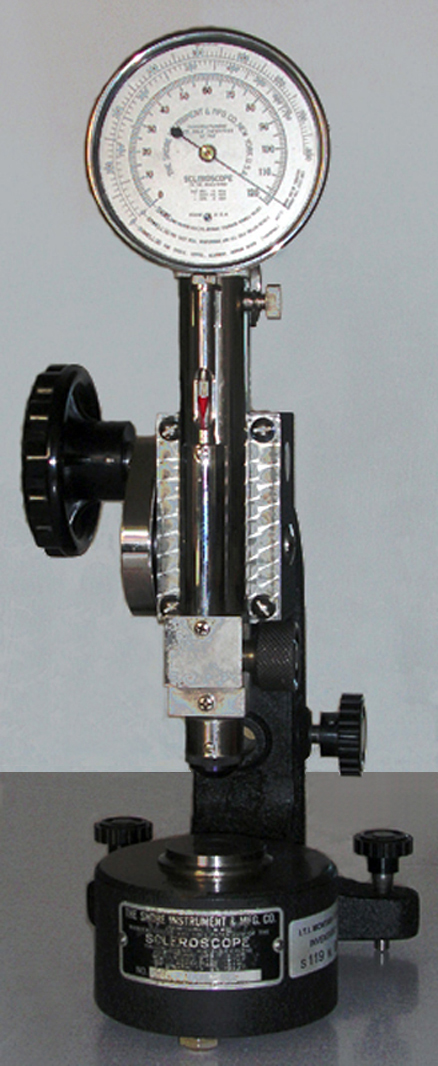
Shore`s Standard Dial Recording Scleroscope. Model D-1. [Prima parte] ( Improved portable). For measuring the hardness of metals with equivalent Standard Brinell Graduations.
La matricola è N° 7812 D come si legge su una etichetta posta sulla base.
Nell`inventario D del 1937 al n° 652 si legge: «Scleroscopio Shore munito di martelletto con punta di diamante, racchiuso in cassetta con i seguenti accessori: un tubo di vetro di ricambio con relativo martelletto per prova materiali teneri. Tre campioni per prova apparecchio. Una piccola chiave in bustina di cartone. – ₤ 1500».
Non si hanno elementi certi che ci si riferisca a questo esemplare o al più antico modello C che ora è esposto al MITI.
Questo strumento è attualmente ancora in uso presso il Laboratorio Tecnologico della Sezione Meccanica.
Non rinvenibile negli inventari, è posteriore di non molti anni (sicuramente databile dopo il 1932) all`esemplare attualmente esposto al Museo MITI.
Le schede relative a quest`ultimo si possono consultare scrivendo “Shore” su Cerca.
Costruito da THE SHORE INSTRUMENTS & MFG. Co., NEW YORK U.S.A., come è scritto anche sul quadrante dove si legge ancora: «Manufactures and sole patentees of the SCLEROSCOPE TR. MK. REGISTERED. PAT. DEC. 15 . 1914 PAT. SEPT. 25 . 1915 PAT. APR. 5 . 1924. Made in U.S.A.».
L`etichetta posta sulla base reca le stesse scritte.
Il modello D-1 rispetto al precedente ha tre scale di lettura concentriche sul quadrante circolare a indice posto nella parte superiore.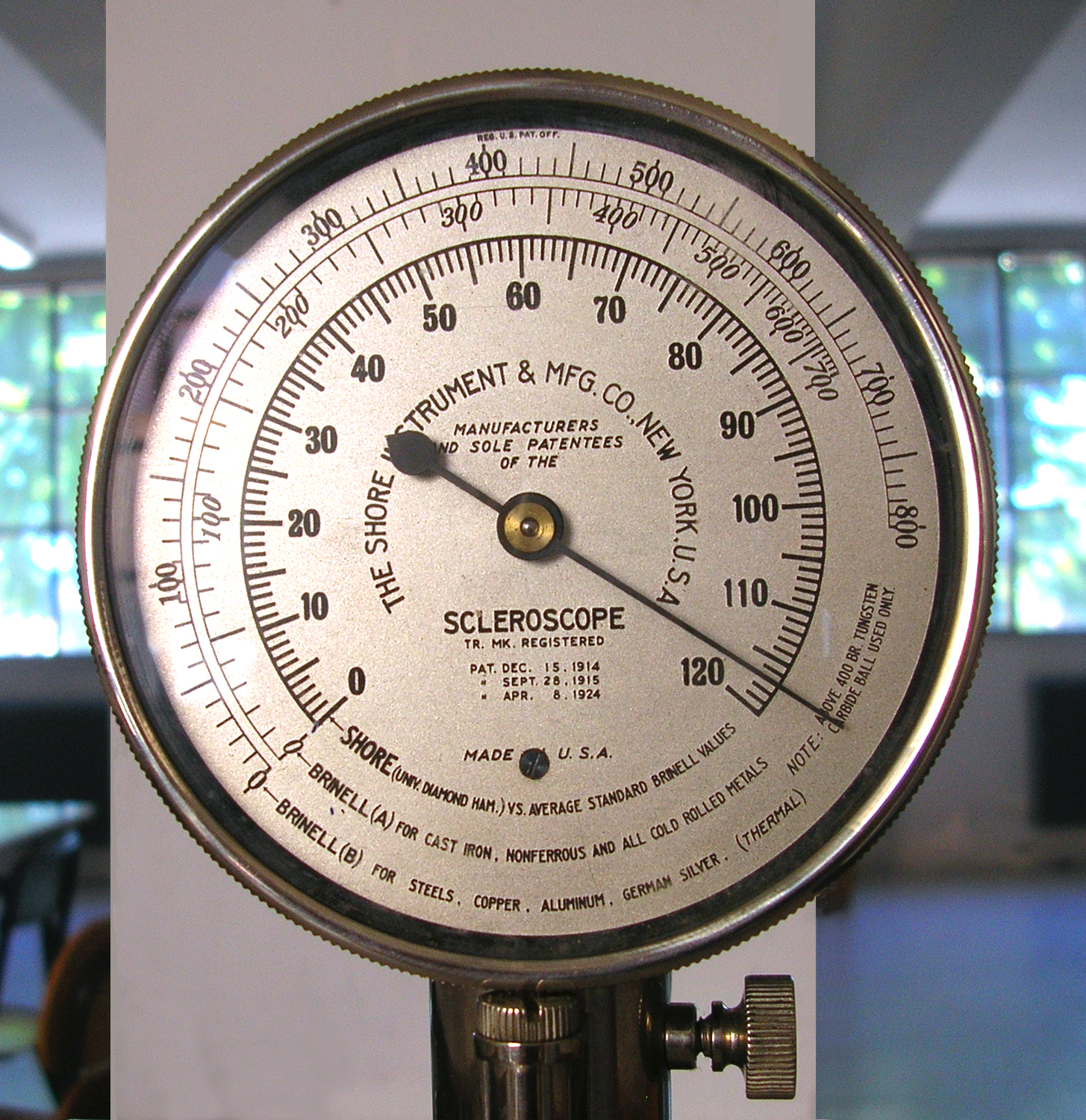 La scala SHORE è la più interna “(Univ. Diamond Ham.) Vs. Average Standard Brinell Values” va da 0 a 120.
La scala SHORE è la più interna “(Univ. Diamond Ham.) Vs. Average Standard Brinell Values” va da 0 a 120.
La Brinell (A) “For Cast Iron, Nonferrous And All Cold Rolled Metals” è intermedia e va da 0 a 700, valore che corrisponde al 90 della Shore.
La Brinell (B) “For Steels, Copper, Aluminum, German Silver, (Thermal)” è vicina al bordo e va da 0 a 800, valore che corrisponde circa al 102 della Shore.
Inoltre vi si legge: “Note: Above 400 Br. Tungsten Carbide Ball Use Only”.
In questo strumento l`altezza a cui rimbalza il martelletto a fine prova si può leggere su un quadrante circolare. Infatti l`indice si arresta in corrispondenza del valore più alto raggiunto.
Il martelletto ha una massa di 36 g e questo permette una corsa inferiore rispetto a quella del Modello C.
Come nel modello C la scala Shore è stata ottenuta dividendo in cento parti l`altezza di rimbalzo che si ottiene dopo che il martelletto ha urtato la superficie di un pezzo di acciaio temprato contenente l`1% di carbonio.
La scala prosegue fino al valore massimo di 120 per materiali più duri come la porcellana.
Prima di eseguire la misura bisogna mettere lo strumento in orizzontale regolando le viti calanti.
Durante la prova bisogna evitare vibrazioni che possono falsare i risultati. Su un foglio posto all`interno della cassetta di custodia si legge: « SPECIAL OPERATING INSTRUCTIONS.
This Model “D” Dial Indicating Scleroscope embodies various improvements over our previous models. Correct manipulation of the knurled operating knob is essential if satisfactory results are to be obtained. Turn the knob clockwise with a brisk, sustained movement until a definite stop is reached. Release the knob and will automatically revolve counter-clockwise as the dial hand comes to rest at the correct hardness. A good rule to ascertain the rapidity with which the Scleroscope should be operated is the speed required to make at least five or six tests in ten seconds. The operating knob actuates a pawl which releases the testing hammer within the instrument. You will note that the knob may be turned gently until an initial stop is reached without releasing the hammer. You will further note that an additional pressure on the knob in the same direction will release the hammer. This additional pressure moves the knob almost imperceptibly, but it does move. This is incorrect operating technique, as momentarily hesitating at the initial stop and then applying increased pressure to release the hammer causes the pawl to scrape against the hammer as it drops. This absorbs part of the hammer`s gravitational energy as it drops, reduces its rebound, and, of course, results in low and inconsistent readings. The clockwise movement must, therefore, be brisk and firmly sustained without any hesitation whatever until a final and definite stop is reached.
THE SHORE INSTRUMENTS & MANUFACTURING CO., Inc. 90-35 Van Wyck Expressway – Jamaica, 2, N.Y.».
Bibliografia: Bulletin S-32 edito dalla ditta costruttrice.
Foto di Claudio Profumieri, consulenza del prof. Egisto Mariani che ringraziamo, elaborazioni, ricerche e testo di Fabio Panfili.
Per ingrandire le immagini cliccare su di esse col tasto destro del mouse e scegliere tra le opzioni.